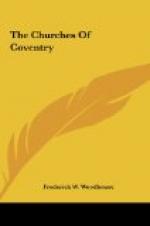Since 1537 the patronage has with that of Trinity, been exercised by the Crown.
The internal evidence of the date of the building is given in the description of the fabric. Of external evidence in the shape of records or deeds we have very little. Tradition says that there was once a brass tablet in the church bearing the following lines:
William and Adam built the Tower,
Ann and Mary built the Spire;
William and Adam built the Church,
Ann and Mary built the Choir.
Now we know that William and Adam Botoner, who were each Mayor thrice between 1358 and 1385, built the tower, spending upon it L100 a year for twenty-two years, but what foundation there is for the other statements cannot now be determined. The tower was in building from 1373 to 1394, and the choir is contemporary with it, the nave was in building from 1432 to 1450, and the spire was begun in 1430. As William was Mayor in 1358 it can hardly have been less than one hundred years after his birth that both nave and spire were begun. It is however, likely that other members of the family (if not he, by bequest) contributed largely to the general building fund.
Much of the history of a parish church is concerned with its internal economy but even the records of this are not quite trivial for they enlighten us on many points wherein we are rightly curious. We are, for instance, constantly reminded, as Dr. Gasquet points out in “Mediaeval Parish Life,” that “religious life permeated society in the Middle Ages, particularly in the fifteenth century, through the minor confraternities” or gilds.
Thus the Drapers’ Gild made itself responsible not only for the upkeep of the Lady Chapel but also for the lights always burning on the Rood-loft, every Master paying four pence for each “prentys” and every “Jurneman” four pence. The cost of lights formed a serious item in church expenditure, needing the rent of houses and lands for their maintenance. Guy de Tyllbrooke, vicar in the late thirteenth century, gave all his lands and buildings on the south side of the church to maintain a light before the high altar, day and night, for ever, “and all persons who shall convert this gift to any other use directly or indirectly shall incur the malediction of Almighty God, the Blessed Virgin, St. Michael and All Saints.”
Royal visits to the church have been noticed in the history of the priory and city, especially that in 1450 which was apparently intended to mark the completion of the church. Reference has also been made to the plays and pageants with which such visitors were entertained. The site for the performance of the cycle of Corpus Christi plays was the churchyard on the north of St. Michael’s. Queen Margaret, whose visits were so frequent that the city acquired the fanciful title of “the Queen’s Bower” came over from Kenilworth on the Eve of the Feast in 1456, “at which time she would not be met, but privily to see the play there on the morrow and she saw then all the pageants played save Doomsday, which might not be played for lack of day and she was lodged at Richard Wood’s the Grocer.”




